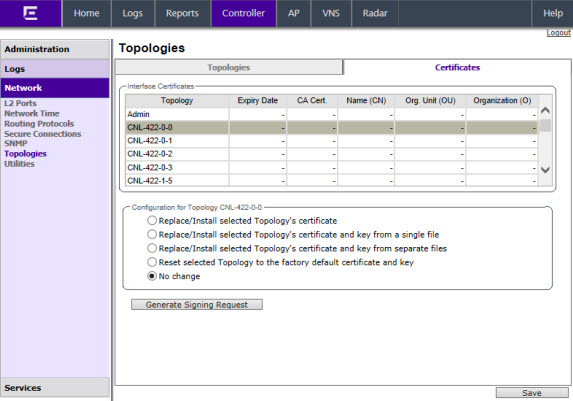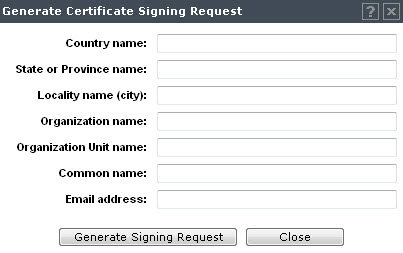To install a certificate for a Controller Data Interface:

Note
There are separate certificates if IPv4 and IPv6 is configured for Admin topology.The Configuration for Topologies section and the Generate Signing Request button become available. Use the field and button descriptions in Topologies Page: Certificates Tab Fields and Buttons to create and install certificates.

Note
The certificate Common Name (CN) must match the interface IP or DNS addresses (Admin only).The Configuration for Topologies section displays.

Topologies Page: Certificates Tab Fields and Buttons
| Field/Button | Description |
|---|---|
| Interface Certificates | |
| Topology | Topology name |
| Expiry Date | Date when the certificate expires |
| CA Cert. | Identifies whether or not a CA certificate has been installed on the topology. |
| Name (CN) | The IP address of DNS address associated with
the topology that the certificate applies to. Note: The Name field supports both IPv4 or IPv6
addresses.
|
| Org Unit (OU) | Name of the organization‘s unit. |
| Organization | Name of the organization |
| Configuration for Topology | |
| Replace/Install selected Topology‘s certificate | To replace/install the existing port‘s
certificate and key using this option, do the following:
|
| Replace/Install selected Topology‘s certificate and key from a single file | To replace the existing port‘s certificate and
key using this option, do the following:
|
| Replace/Install selected Topology‘s certificate and key from separate files | To replace the existing port‘s certificate and
key using this option, do the following:
|
| Reset selected Topology to the factory default certificate and key | Remove custom certificate that user installed. |
| No change | No change. |
| Generate Signing Request | To generate a CSR for the controller, click Generate Signing Request. The Generate Certificate Signing Request window displays (Generate Certificate Signing Request Window) |
| Save | Click to save the changes to this Topology. |

Note
To avoid the certificate-related web browser security warnings when accessing the Wireless Assistant, you must also import the customized certificates into your web browser application.
Generate Certificate Signing Request Page - Fields and Buttons
| Field/Button | Description |
|---|---|
| Country name | The two-letter ISO abbreviation of the name of the country |
| State or Province name | The name of the State/Province |
| Locality name (city) | The name of the city. |
| Organization name | The name of the organization |
| Organizational Unit name | The name of the unit within the organization. |
| Common Name | Set the common name to be one of the
following: the IP address of the interface that the CSR applies to. a DNS address associated with the IP address of the interface that the CSR applies to. |
| Email address | The email address of the organization |
| Generate Signing Request | Click to generate a signing request. A certificate request file is generated (.csr file extension). The name of the file is the IP address of the topology you created the CSR for. The File Download dialog is displayed. |